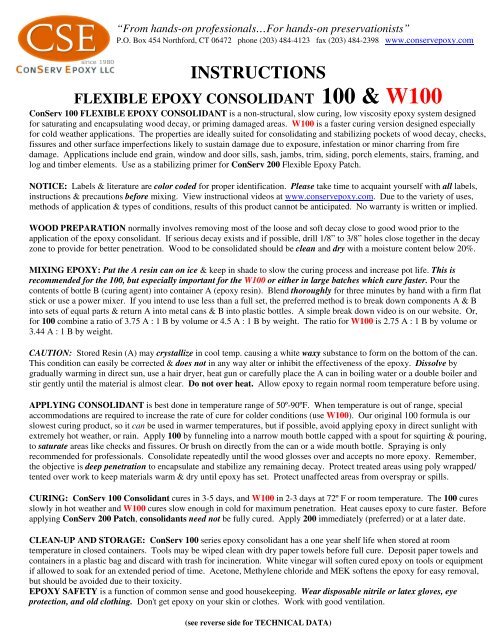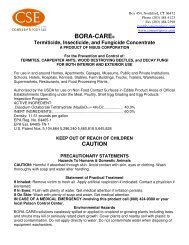Instructions and Technical Data - Conserv Epoxy LLC
Instructions and Technical Data - Conserv Epoxy LLC
Instructions and Technical Data - Conserv Epoxy LLC
Create successful ePaper yourself
Turn your PDF publications into a flip-book with our unique Google optimized e-Paper software.
“From h<strong>and</strong>s-on professionals…For h<strong>and</strong>s-on preservationists”<br />
P.O. Box 454 Northford, CT 06472 phone (203) 484-4123 fax (203) 484-2398 www.conservepoxy.com<br />
INSTRUCTIONS<br />
FLEXIBLE EPOXY CONSOLIDANT 100 & W100<br />
ConServ 100 FLEXIBLE EPOXY CONSOLIDANT is a non-structural, slow curing, low viscosity epoxy system designed<br />
for saturating <strong>and</strong> encapsulating wood decay, or priming damaged areas. W100 is a faster curing version designed especially<br />
for cold weather applications. The properties are ideally suited for consolidating <strong>and</strong> stabilizing pockets of wood decay, checks,<br />
fissures <strong>and</strong> other surface imperfections likely to sustain damage due to exposure, infestation or minor charring from fire<br />
damage. Applications include end grain, window <strong>and</strong> door sills, sash, jambs, trim, siding, porch elements, stairs, framing, <strong>and</strong><br />
log <strong>and</strong> timber elements. Use as a stabilizing primer for ConServ 200 Flexible <strong>Epoxy</strong> Patch.<br />
NOTICE: Labels & literature are color coded for proper identification. Please take time to acquaint yourself with all labels,<br />
instructions & precautions before mixing. View instructional videos at www.conservepoxy.com. Due to the variety of uses,<br />
methods of application & types of conditions, results of this product cannot be anticipated. No warranty is written or implied.<br />
WOOD PREPARATION normally involves removing most of the loose <strong>and</strong> soft decay close to good wood prior to the<br />
application of the epoxy consolidant. If serious decay exists <strong>and</strong> if possible, drill 1/8” to 3/8” holes close together in the decay<br />
zone to provide for better penetration. Wood to be consolidated should be clean <strong>and</strong> dry with a moisture content below 20%.<br />
MIXING EPOXY: Put the A resin can on ice & keep in shade to slow the curing process <strong>and</strong> increase pot life. This is<br />
recommended for the 100, but especially important for the W100 or either in large batches which cure faster. Pour the<br />
contents of bottle B (curing agent) into container A (epoxy resin). Blend thoroughly for three minutes by h<strong>and</strong> with a firm flat<br />
stick or use a power mixer. If you intend to use less than a full set, the preferred method is to break down components A & B<br />
into sets of equal parts & return A into metal cans & B into plastic bottles. A simple break down video is on our website. Or,<br />
for 100 combine a ratio of 3.75 A : 1 B by volume or 4.5 A : 1 B by weight. The ratio for W100 is 2.75 A : 1 B by volume or<br />
3.44 A : 1 B by weight.<br />
CAUTION: Stored Resin (A) may crystallize in cool temp. causing a white waxy substance to form on the bottom of the can.<br />
This condition can easily be corrected & does not in any way alter or inhibit the effectiveness of the epoxy. Dissolve by<br />
gradually warming in direct sun, use a hair dryer, heat gun or carefully place the A can in boiling water or a double boiler <strong>and</strong><br />
stir gently until the material is almost clear. Do not over heat. Allow epoxy to regain normal room temperature before using.<br />
APPLYING CONSOLIDANT is best done in temperature range of 50º-90ºF. When temperature is out of range, special<br />
accommodations are required to increase the rate of cure for colder conditions (use W100). Our original 100 formula is our<br />
slowest curing product, so it can be used in warmer temperatures, but if possible, avoid applying epoxy in direct sunlight with<br />
extremely hot weather, or rain. Apply 100 by funneling into a narrow mouth bottle capped with a spout for squirting & pouring,<br />
to saturate areas like checks <strong>and</strong> fissures. Or brush on directly from the can or a wide mouth bottle. Spraying is only<br />
recommended for professionals. Consolidate repeatedly until the wood glosses over <strong>and</strong> accepts no more epoxy. Remember,<br />
the objective is deep penetration to encapsulate <strong>and</strong> stabilize any remaining decay. Protect treated areas using poly wrapped/<br />
tented over work to keep materials warm & dry until epoxy has set. Protect unaffected areas from overspray or spills.<br />
CURING: ConServ 100 Consolidant cures in 3-5 days, <strong>and</strong> W100 in 2-3 days at 72º F or room temperature. The 100 cures<br />
slowly in hot weather <strong>and</strong> W100 cures slow enough in cold for maximum penetration. Heat causes epoxy to cure faster. Before<br />
applying ConServ 200 Patch, consolidants need not be fully cured. Apply 200 immediately (preferred) or at a later date.<br />
CLEAN-UP AND STORAGE: ConServ 100 series epoxy consolidant has a one year shelf life when stored at room<br />
temperature in closed containers. Tools may be wiped clean with dry paper towels before full cure. Deposit paper towels <strong>and</strong><br />
containers in a plastic bag <strong>and</strong> discard with trash for incineration. White vinegar will soften cured epoxy on tools or equipment<br />
if allowed to soak for an extended period of time. Acetone, Methylene chloride <strong>and</strong> MEK softens the epoxy for easy removal,<br />
but should be avoided due to their toxicity.<br />
EPOXY SAFETY is a function of common sense <strong>and</strong> good housekeeping. Wear disposable nitrile or latex gloves, eye<br />
protection, <strong>and</strong> old clothing. Don't get epoxy on your skin or clothes. Work with good ventilation.<br />
(see reverse side for TECHNICAL DATA)
“From h<strong>and</strong>s-on professionals…For h<strong>and</strong>s-on preservationists”<br />
P.O. Box 454 Northford, CT 06472 phone (203) 484-4123 fax (203) 484-2398 www.conservepoxy.com<br />
TECHNICAL DATA<br />
FLEXIBLE EPOXY CONSOLIDANT 100 & W100<br />
ConServ 100 FLEXIBLE EPOXY CONSOLIDANT is a non-structural, slow curing, low viscosity epoxy system designed<br />
for saturating <strong>and</strong> encapsulating wood decay, or priming damaged areas. W100 is a faster curing version designed especially<br />
for cold weather applications. The properties are ideally suited for consolidating <strong>and</strong> stabilizing pockets of wood decay, checks,<br />
fissures <strong>and</strong> other surface imperfections likely to sustain damage due to exposure, infestation or minor charring from fire<br />
damage. Applications include end grain, window <strong>and</strong> door sills, sash, jambs, trim, siding, porch elements, stairs, framing, <strong>and</strong><br />
log <strong>and</strong> timber elements. Use as a stabilizing primer for ConServ 200 Flexible <strong>Epoxy</strong> Patch.<br />
CURE SCHEDULE<br />
Pot life 100<br />
Gel time<br />
Final cure<br />
Pot life W100<br />
Gel time<br />
Final cure<br />
PROPERTIES<br />
Color<br />
Viscosity<br />
Operating range<br />
Mixing temp. range<br />
Shelf life<br />
PACKAGING & YIELD<br />
4 oz. mass - approx. 4-6 hrs. @ 72º F<br />
4 oz. mass - approx. 1½-3 days @ 72º F<br />
3-5 days @ 72º F (approx. 75% cured)<br />
4 oz. mass - approx. 1-2 hrs. @ 72º F<br />
4 oz. mass - approx. 12-24 hrs. @ 72º F<br />
2-3 days @ 72º F (approx. 75% cured)<br />
DO NOT use below 50º F.<br />
AVOID exposure to intense sunlight until final cure is complete.<br />
Clear<br />
Consistency of vegetable oil @ 72º F<br />
-30º F to 160º F<br />
50º F to 90º F<br />
1 year in unopened original containers<br />
ConServ 100 & W100 are supplied in ½ gallon, 1 quart, 1 pint, ½ pint, <strong>and</strong> ¼ pint quantities. Coverage is variable<br />
depending on the extent of the decay <strong>and</strong> subsequent degree of saturation. Sufficient saturation to stabilize the<br />
damaged material is imperative for proper protection <strong>and</strong> preparation for the ConServ 200 patch.<br />
(See reverse side for INSTRUCTIONS)



